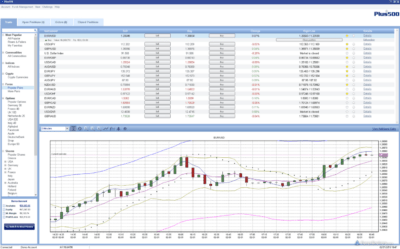Contents
Sometimes, the A/D indicator simply doesn’t work — No one indicator provides accurate predictions 100% of the time. That’s why it’s essential to use other tools alongside your Accumulation/Distribution indicator. The one who developed the A/D indicator was the famous trader and analyst Marc Chaikin. He initially referred to it as the Cumulative Money Flow Line. Your ability to open a DTTW trading office or join one of our trading offices is subject to the laws and regulations in force in your jurisdiction. Due to current legal and regulatory requirements, United States citizens or residents are currently unable to open a trading office with us.
The accumulation/distribution index adds up volume multiplied by the CLV factor, i.e. Mr. Pines has traded on the NYSE, CBOE and Pacific Stock Exchange. In 2011, Mr. Pines started his own consulting firm through which he advises law firms and investment professionals on issues related to trading, and derivatives.
Also, one of the main uses of the indicator is to monitor for divergences. Divergences can last a long time and are poor timing signals. When divergence appears between the indicator and price, it doesn’t mean a reversal is imminent. It may take a long time for the price to reverse, or it may not reverse at all.
The Klinger Oscillator was developed by Stephen J. Klinger. This indicator takes market volume and organizes it into wave charts, clearly highlighting Is Umarkets Forex Broker recommended for beginners in trading inflection points and regions of supply/demand. Try tuning this for your instrument by adjusting the “Trend Detection Length”.
This stop-loss area is highlighted with the red horizontal line on the chart. If the ADL and the OBV are increasing on high volumes, you should hold your long trade. When this happens you enter the trade in the direction of the trend.
- The accumulation distribution line is a cumulative measure of the flow of volume or money of every time.
- The increasing volumes are used to confirm the validity of the signal.
- Both volume and where the price closes within the period’s range determine how much the A/D will decline.
- In summary, the Accumulation Distribution Line is a very effective tool to confirm price action and show warnings of potential price reversals.
This indicator is considered one of the most widely used volume indicators. To get a bullish ADL divergence we need to identify a couple of things on the chart. There is a substantial risk of loss in trading futures, options and forex.
Technical Indicators
The purpose of the indicator is to serve as a volume-based confirmation of signals given by other indicators, typically… If you’re familiar with the On-Balance Volume indicator, you know that, much like the A/D indicator, it also uses price and volume to predict market movements. Spot price-volume divergences — The Accumulation/Distribution line also tells us if the current price and volume are not in agreement, which could mean a potential reversal soon. The A/D indicator tells us a lot about market behavior, specifically, what impact demand and supply have on the asset’s price.

It is usually followed by a change in the trend of the security from downward to upward. A positive money flow multiplier means there is more substantial buying pressure . That pressure, in turn, should then correlate with a rising price. The indicator provides insight into the strength of a trend.
Formula
This can cause a disconnect between the indicator and the price, especially for minor price changes. John Murphy’s Technical Analysis of the Financial Markets covers it all with explanations that are simple and clear. Murphy covers most the major charts patterns and indicators. A complete chapter is devoted to understanding volume and open interest.
Moreover, the Money Flow Multiplier does not take into account price changes from period to period. As such, it cannot be expected to always affirm price action or successfully predict price reversals with divergences. Sometimes there is a disconnect between prices and the indicator. Sometimes the Accumulation Distribution Line simply doesn’t work. This is why it is vitally important to use the Accumulation Distribution Line, and all indicators for that matter, in conjunction with price/trend analysis and/or other indicators. The accumulation/distribution indicator (A/D) is a cumulative indicator that uses volume and price to assess whether a stock is being accumulated or distributed.

The ADL and the OBV indicators are concentrated in the upper area. To determine the right place for your S/L order, you should use standard price action rules. The answer to this question is due to the differences in the formulas of these indicators.
Lawrence has served as an expert witness in a number of high profile trials in US Federal and international courts. On average, more volume was occurring on down days than up days, even while the Nasdaq 100 was making higher highs and higher lows, which usually is considered a sign of strength. The bearish divergence from Low #1 to Low #2 confirmed the later bearish divergence of High #3 to High #4. This bearish divergence warned that the second move to make a higher high in price lacked conviction. This failure of the Accumulation Distribution Line signaled a strong bearish divergence.
Every transaction between buyers and sellers determines a security’s volume. Every time a buyer requests to purchase what a seller is offering at a specific Is Forex.com a Brokerage Firm We Can Trust price, there has been a single transaction. A cumulative indicator that evaluates whether a stock is being dispersed or accumulated using volume and price.
Pros and cons of the A/D indicator
Forex accounts are not available to residents of Ohio or Arizona. Futures and futures options trading involves substantial risk and is not suitable for all investors. Please read theRisk Disclosure Statementprior to trading futures products. Past performance of a security or strategy is no guarantee of future results or investing success. Battle Mountain’s price diverged as it reached new highs in late July while the indicator was falling.
A high positive multiplier combined with high volume shows strong buying pressure that pushes the indicator higher. Conversely, a low negative number combined with high volume reflects strong selling pressure that pushes the indicator lower. Money Flow Volume accumulates to form a line that either confirms or contradicts the underlying price trend. In this regard, the indicator is used to either reinforce the underlying trend or cast doubts on its sustainability. An uptrend in prices with a downtrend in the Accumulation Distribution Line suggests underlying selling pressure that could foreshadow a bearish reversal on the price chart.
Now, we will learn about the accumulation/distribution indicator (A/D), one of the most widely used indicators. Here’s a snippet of the VBA – the part that programmatically writes the formulas that calculate ADL and OBV into a range of cells. A value of zero would mean that the price closed halfway between the high and low of the range. The starting point for the acc/dist total, i.e. the zero point, is arbitrary, only the shape of the resulting indicator is used, not the actual level of the total.
On the other hand, the stochastic oscillator swung between the overbought and oversold regions but mainly remained in the oversold region. This is a classic example of how using a single indicator can be misleading. This is the reason the accumulation/distribution line cannot confirm a trend independently without using other indicators. The A/D line demonstrates how factors affecting supply and demand are affecting price. A/D may move in the same or opposite direction as price fluctuations. To calculate, find the close, high, and low of the most recent period.

The indicator is based on the relation between the volume flow, or money flow, and the rise and fall of an asset price. It is used to identify divergences between the volume and the price that indicate entry and exit points for trading positions. The accumulation/distribution indicator looks at the relationship between an asset’s price and its volume flow to determine the trend of a stock and the strength behind that trend. “Accumulation” basically refers to the buying level for that security within a given period.
Indicators M ~ N
These two signals are crucial for the success of the accumulation distribution indicator oscillator. Traders use them to set entry and exit points on the chart in order to hop into emerging trends and exit at the right moment. The accumulation distribution indicator line provides two types of signals – trend confirmation and divergence.
The accumulation/distribution line helps to show how supply and demand factors are affecting price. A/D indicator can move in the same direction as price changes or it may move in the opposite direction. A rising A/D line votes for an uptrend where a falling A/D line votes for a downtrend. If the A/D line is moving higher on a chart, it indicates the asset is under accumulation, and buying interest is increasing. That could present an opportunity to buy the asset ahead of further gains in the price.
It does not look at the price change between different periods. The calculation of the Who is Maxitrade Broker – Visual inspection and review consists of three components- money flow multiplier , money flow volume , and accumulation distribution line . Accumulation Distribution tracks the relationship between price and volume and acts as a leading indicator of price movements.
